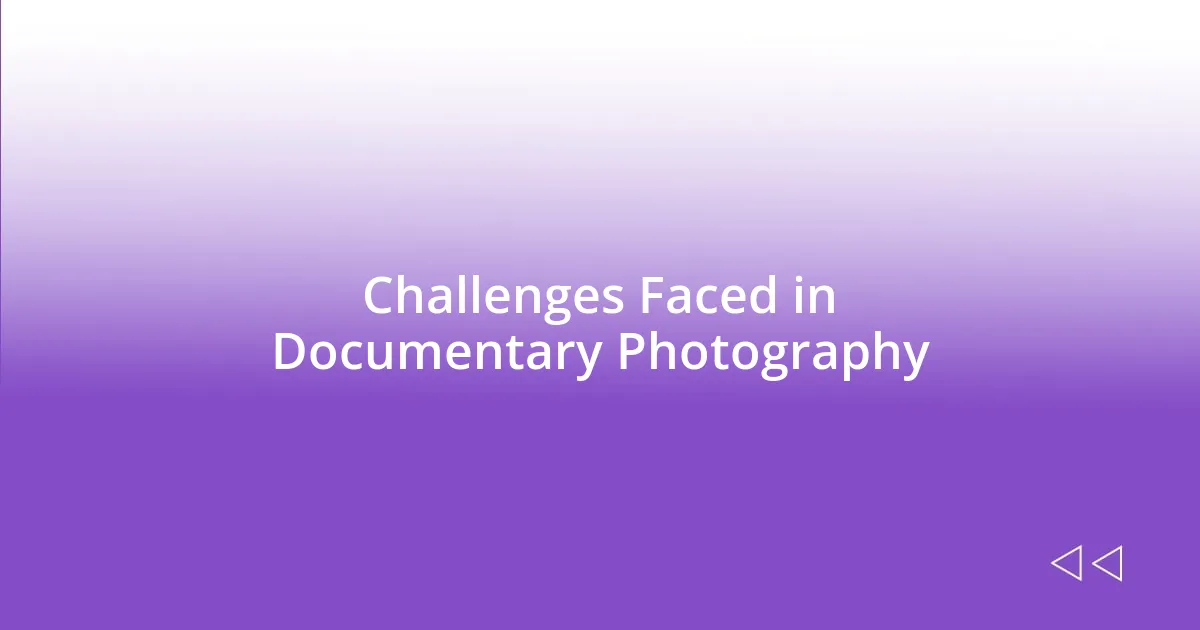Key takeaways:
- Documentary photography captures authentic moments and emotions, revealing deeper narratives within everyday life.
- Building trust with subjects and being present in the moment enhances the authenticity of photographs.
- Challenges such as ethical dilemmas and environmental unpredictability can lead to unexpected and powerful storytelling opportunities.
- Embracing spontaneity and reflecting on captured moments enriches both the photographer’s experience and the storytelling process.

Introduction to Documentary Photography
Documentary photography, to me, is like a visual diary that captures the pulse of life as it unfolds. I remember the first time I held a camera and documented a local festival; the laughter, the colorful displays, and the intimate connections I witnessed enriched my understanding of community. Isn’t it fascinating how a single snapshot can tell a story that words sometimes can’t convey?
At its core, documentary photography aims to showcase real events and emotions, bringing light to stories that deserve to be told. When I ventured into capturing everyday moments, I was often surprised by how much depth and narrative existed in ordinary scenes. Have you ever noticed how the simplest gestures can reveal profound truths about humanity?
This genre serves as a powerful tool for social change, offering a fresh lens through which we can view societal issues. I vividly recall a photo project focused on poverty in my town; it opened my eyes to the struggles many face and ignited a passion in me for advocacy. How often do we overlook these pressing realities, only to be confronted by them through thought-provoking images?

What Inspired My Photography Journey
My journey into documentary photography traces back to my childhood, when I’d sneak around my neighborhood with my grandfather’s old film camera. I remember capturing my friends playing soccer in the empty lot across the street; their carefree laughter and competitive spirit inspired a profound sense of nostalgia in me. I realized then that photography could freeze moments in time, preserving the essence of youth and joy that often slips away too quickly.
- The warmth in my grandfather’s smile when he first taught me to frame a shot made photography personal for me.
- I often explored the idea of storytelling through lenses, finding beauty in everyday struggles, much like the way sunlight filters through a dusty window.
- Each click of the shutter felt like a heartbeat, reminding me to cherish the fleeting nature of life and connection.
Being immersed in those formative memories laid the groundwork for what would become a lifelong passion. My first photography class in high school solidified my love for the craft; the discussions around ethics, composition, and the power of imagery were exhilarating. I’ll never forget the moment I printed my first photo in the darkroom—it was like witnessing magic, as my image slowly emerged on the paper. That experience reaffirmed my desire to use my camera as a means of expressing raw, unfiltered reality.

Techniques for Capturing Real Moments
Capturing real moments in documentary photography requires a keen awareness of your surroundings. Whether it’s the subtle expressions on people’s faces or the ambiance of an impromptu gathering, being present is key. I often find that my most moving photos occur when I’m not actively posing subjects; rather, I let life unfold and capture authentic interactions. There’s a certain beauty in spontaneity that a posed shot could never replicate.
Moreover, the technique of using natural light can profoundly impact the mood of your images. I still recall an afternoon spent in a bustling market where the soft light filtering through the tents painted everything in a warm, golden glow. That light accentuated emotions and relationships, making each shot feel intimate and alive. It’s about finding the right moment when everything aligns, and I’ve learned that sometimes you just need to wait and observe.
In addition to technical settings, developing a sense of trust with your subjects can create a more comfortable atmosphere for candid shots. I remember photographing a family gathering where I connected with them over shared stories and laughter. Once they felt at ease, their genuine interactions became a rich tapestry of emotions that I was lucky enough to document with my lens. This rapport often results in images that speak volumes without any words.
| Technique | Description |
|---|---|
| Being Present | Observe and capture spontaneous interactions without staging moments. |
| Using Natural Light | Utilize the surrounding light to enhance the mood and emotion of the scene. |
| Building Trust | Engage with subjects to foster comfort, allowing for genuine expressions and actions. |

Challenges Faced in Documentary Photography
One of the biggest challenges I’ve encountered in documentary photography is gaining access to private moments. There’s a certain vulnerability in capturing someone’s life, and I’ve often found people hesitant to allow me into their world. I’ll never forget one instance in a small village where I wanted to document a local festival. Initially, people looked at me with suspicion, but as I chatted with them about their traditions, I gradually earned their trust. It taught me that empathy goes a long way in this field; without it, those raw, authentic moments remain locked away, in a world I may never see.
Another hurdle is the ever-present ethical dilemma of storytelling versus exploitation. In my experience, I’ve struggled with how to strike a balance between portraying reality and ensuring I respect my subjects’ dignity. I recall photographing a community facing poverty, where I was torn between showcasing their struggles and not wanting to objectify their plight. How do you tell a story that honors their humanity while shedding light on harsh realities? It’s a delicate line I constantly navigate; my camera can illuminate, but it can also cast shadows if wielded carelessly.
Weather, time constraints, and unexpected circumstances also add layers of difficulty to this art form. I once had my heart set on capturing a sunrise ceremony by the river. The sky turned cloudy, and it began to rain just moments before the event began. Rather than feeling defeated, I realized that sometimes, embracing the unpredictability can lead to magic. I captured the participants in the soft rain, which added a layer of emotion and intimacy to the images, highlighting their resilience. It’s in these moments of challenge that I feel the most empowered as a storyteller. Have you ever faced a situation that transformed your expectations into something unexpectedly beautiful? It’s remarkable how adversity can lead to profound storytelling.

Stories Behind My Favorite Photos
One of my favorite photos was taken during a street performance in a bustling urban environment. I remember the energy of the crowd; people were laughing, cheering, and sharing in the joy of the moment. I snapped an image of a little girl, eyes wide with wonder, completely engrossed in the act. Capturing that genuine spark of joy reminded me why I love documentary photography—there’s something magical about freezing a fleeting moment that encapsulates pure happiness.
Another cherished photo comes from a quiet afternoon spent at a local nursing home. I found myself drawn to a resident who often sat by the window, lost in thought. One day, as sunlight flooded the room, I took a candid shot of her reflecting on the world outside. When I later shared the image with her family, their gratitude was overwhelming; they felt I had captured their mother’s spirit. It’s moments like these that affirm why it’s important to be present—not just in the technical sense, but emotionally too. Have you ever captured a moment that felt like it reached beyond the photograph? That connection between the subject and the viewer can transcend time.
Then there’s the photo I took during a community cleanup event. I was initially struggling to find the right angles, but when I caught a glimpse of a young boy helping an elderly man pick up trash, something clicked. The contrast between their ages, the genuine camaraderie, and the determination on their faces all came together beautifully. It’s moments like these that expose the heart of a community—reminding us how often ordinary actions reveal profound bonds. What stories do your photos tell about community and connection? It’s a reminder that every photograph holds a story, waiting to be shared.

Tips for Aspiring Documentary Photographers
To excel in documentary photography, one of the essential tips I can share is to always approach your subjects with genuine curiosity and openness. I once found myself in a rural community, eager to document their daily life. However, instead of directly diving into shooting, I spent time listening to their stories. Building rapport not only led to more intimate images but also opened doors to moments I never could’ve captured otherwise. Have you ever felt the difference that a little patience can make in your work? It’s truly transformative.
Another critical piece of advice is to embrace spontaneity. I vividly remember a bustling marketplace where I intended to photograph vendors selling their produce. Instead, I noticed a group of children playing nearby, laughing and chasing each other amidst the chaos. Capturing that unexpected joy took my project in a new direction, reminding me that the most compelling stories often lie outside our initial plans. Isn’t it fascinating how life can surprise us when we least expect it?
Lastly, I believe in the power of reflection. After completing a project, I often sit down with my images and ask myself what I learned from those moments. For instance, while reviewing photos from a cultural event, I discovered deeper stories about resilience and celebration that I initially overlooked. How often do we pause to ponder the narratives behind our photographs? Taking time to reflect enriches our understanding and can guide our future work, making it more meaningful.














